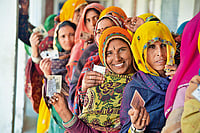JUST five years ago, before Manmohan Singh unleashed the forces of free enterprise, globalisation and market economy upon us, the Indian market was largely an anachronism. Several generations of technology had passed us by; indifferent quality and limited choice were the norm in category after category of products. By contrast, the foreign world was like a wonderland to most of us, a shopper's paradise, a consumer's nirvana. Generations of Indians had grown up treasuring the odd gadget brought back by relatives returning from trips abroad. Those of us who ever got a chance to travel overseas were like kids in a candy store, salivating at the sight of all the goodies around.
Yet, today, this same phoren -crazy nation of Indians yawns at the announcement of a new brand of Scotch, idly turns over the ad for "America's original brand of jeans", coolly compares the charms of a Sony with that of a Videocon or BPL. In five short years, the Indian has transformed from someone who drooled at the mere sight of foreign goods to a blase 'man-of-the-world'. Incredible.
But what can possibly explain this transformation? It's not as if every other nation or culture goes through a similarly quick process of disenchantment. In fact, the experiences of China, Latin America, the Pacific Rim and East Europe show that the craze for foreign products and brands only grows with time. Having once tasted blood, people normally display an increasingly voracious appetite for things foreign. So how is India different?
Perhaps an essential difference lies in the fact that unlike, say, in China, where soft drinks, jeans, fast-food restaurants, chocolate and cars signified a definitive break with the country's socialist past and a link with the new world of freedom and choice, they were not loaded with any of these profound meanings in India. After centuries of colonial rule, India is not unfamiliar with the western way of life. And although not all of us were able to afford them, we have been familiar for decades with western products like soft drinks, cars, chocolates, jeans or lipsticks. So, most of the new brands rushing into the country do not represent radically new concepts to us. Levi's is only another brand of trousers; Pepsi merely yet another soft drink. And so on.
Besides, although it may appear contrary from the mad hankering for phoren goods that typified the Indian till a while ago, he has never been particularly in awe of western culture or people. The Indian society and worldview have been shaped largely by a fatalistic, god fearing attitude (sambhavami yuge yuge) and the Brahminical order imposed by our caste system. Both emphasise the need for godliness, asceticism and the supremacy of intellectual over material pursuits.
Similarly, Indians don't necessarily look up to the western way of life as being superior or generally more worthy merely because it is materially more advanced. Thus, foreign brands entering the country also do not represent a new or better way of life merely because they are foreign.
Lastly, in an ironical way, the entry of some of the world's biggest brands and their availability at our doorstep have actually helped raise the self-confidence of the Indian psyche. For one, foreign brands and global technology have forced Indian products to upgrade their quality and today we are nowhere as apologetic or dismissive of the quality of the Indian produce as we were a while ago. Also, that the same brands and products we hankered after are today wooing us has altered in a subtle way the equation between Indians and the outside world.
Today, there is evidence all around of our newfound confidence. Unlike in the past, when 'modern' or 'premium' was automatically equated with 'westernised', today most successful advertising is rooted in an Indian reality, depicting an Indian ethos and lifestyle. The advertising for Pepsi, Ariel, Surf Ultra, Kit Kat, Cadbury's Dairy Milk, Titan—all modern and upmarket brands—are cases in point.
So are we saying that Indians are actually becoming impervious to foreign influences? Not really. It is just that we seem to have this amazing ability to absorb influences, amalgamate them in our own popular culture (making a sort of khichri in the process) and only then do we accept them. On our terms. Consider what we've done with popular music, food, movies.
What does all this mean for someone trying to market a foreign brand in India? Clearly, it's important to recognise that while Indians have no resistance as such to foreign brands and influences, we are not overly awed by them either. We have a healthy respect for our own popular culture, our own way of life, and we tend to accept these influences on our terms.
It is not as if foreign brands have not been successful (several of them are clearly doing well); the point is they are not necessarily doing well because of their foreign-ness. If they are succeeding, it's probably because they offer better quality or service or value for money, or because they've been able to fit into our lifestyle and culture. But (and this is the essential thesis of this article), their appeal does not spring centrally from their foreignness, their badge of 'Americana' or their being symbolic of the West. It may then be worth keeping some of these lessons in mind:
It is important to integrate the brand into the cultural milieu of the country, to speak the Indian language. To use the words from the recent launch campaigns of two global brands, the overall tone needs to move from "Gee, it's great to be here" to "Namaste".


























